OCZ RevoDrive 3 X2 (480GB) Preview: 200K IOPS & 1.5GB/s for $1699?
by Anand Lal Shimpi on June 28, 2011 12:00 PM EST- Posted in
- Storage
- SSDs
- SandForce
- OCZ
- RevoDrive
- SF-2000
- RevoDrive 3
- RevoDrive 3 X2
AnandTech Storage Bench 2011
Last year we introduced our AnandTech Storage Bench, a suite of benchmarks that took traces of real OS/application usage and played them back in a repeatable manner. I assembled the traces myself out of frustration with the majority of what we have today in terms of SSD benchmarks.
Although the AnandTech Storage Bench tests did a good job of characterizing SSD performance, they weren't stressful enough. All of the tests performed less than 10GB of reads/writes and typically involved only 4GB of writes specifically. That's not even enough exceed the spare area on most SSDs. Most canned SSD benchmarks don't even come close to writing a single gigabyte of data, but that doesn't mean that simply writing 4GB is acceptable.
Originally I kept the benchmarks short enough that they wouldn't be a burden to run (~30 minutes) but long enough that they were representative of what a power user might do with their system.
Not too long ago I tweeted that I had created what I referred to as the Mother of All SSD Benchmarks (MOASB). Rather than only writing 4GB of data to the drive, this benchmark writes 106.32GB. It's the load you'd put on a drive after nearly two weeks of constant usage. And it takes a *long* time to run.
1) The MOASB, officially called AnandTech Storage Bench 2011 - Heavy Workload, mainly focuses on the times when your I/O activity is the highest. There is a lot of downloading and application installing that happens during the course of this test. My thinking was that it's during application installs, file copies, downloading and multitasking with all of this that you can really notice performance differences between drives.
2) I tried to cover as many bases as possible with the software I incorporated into this test. There's a lot of photo editing in Photoshop, HTML editing in Dreamweaver, web browsing, game playing/level loading (Starcraft II & WoW are both a part of the test) as well as general use stuff (application installing, virus scanning). I included a large amount of email downloading, document creation and editing as well. To top it all off I even use Visual Studio 2008 to build Chromium during the test.
The test has 2,168,893 read operations and 1,783,447 write operations. The IO breakdown is as follows:
| AnandTech Storage Bench 2011 - Heavy Workload IO Breakdown | ||||
| IO Size | % of Total | |||
| 4KB | 28% | |||
| 16KB | 10% | |||
| 32KB | 10% | |||
| 64KB | 4% | |||
Only 42% of all operations are sequential, the rest range from pseudo to fully random (with most falling in the pseudo-random category). Average queue depth is 4.625 IOs, with 59% of operations taking place in an IO queue of 1.
Many of you have asked for a better way to really characterize performance. Simply looking at IOPS doesn't really say much. As a result I'm going to be presenting Storage Bench 2011 data in a slightly different way. We'll have performance represented as Average MB/s, with higher numbers being better. At the same time I'll be reporting how long the SSD was busy while running this test. These disk busy graphs will show you exactly how much time was shaved off by using a faster drive vs. a slower one during the course of this test. Finally, I will also break out performance into reads, writes and combined. The reason I do this is to help balance out the fact that this test is unusually write intensive, which can often hide the benefits of a drive with good read performance.
There's also a new light workload for 2011. This is a far more reasonable, typical every day use case benchmark. Lots of web browsing, photo editing (but with a greater focus on photo consumption), video playback as well as some application installs and gaming. This test isn't nearly as write intensive as the MOASB but it's still multiple times more write intensive than what we were running last year.
As always I don't believe that these two benchmarks alone are enough to characterize the performance of a drive, but hopefully along with the rest of our tests they will help provide a better idea.
The testbed for Storage Bench 2011 has changed as well. We're now using a Sandy Bridge platform with full 6Gbps support for these tests. All of the older tests are still run on our X58 platform.
AnandTech Storage Bench 2011 - Heavy Workload
We'll start out by looking at average data rate throughout our new heavy workload test:
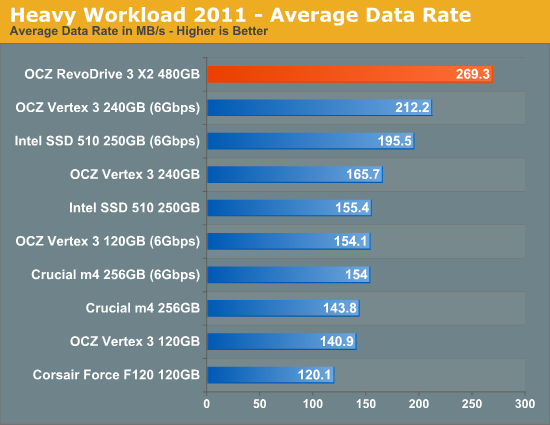
Average performance in our Heavy workload is improved over a single Vertex 3, but not tremendously. Where we really see a tremendous performance increase is when we look at the breakdown of reads/writes:
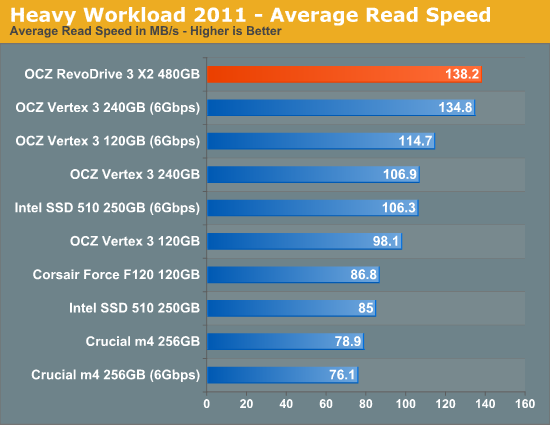

Write speed is much improved over a single 240GB Vertex 3. It's not quite the improvement you'd expect from a 4-controller configuration, but I'd expect that this is the sort of performance improvement most workstation users would see.
The next three charts just represent the same data, but in a different manner. Instead of looking at average data rate, we're looking at how long the disk was busy for during this entire test. Note that disk busy time excludes any and all idles, this is just how long the SSD was busy doing something:
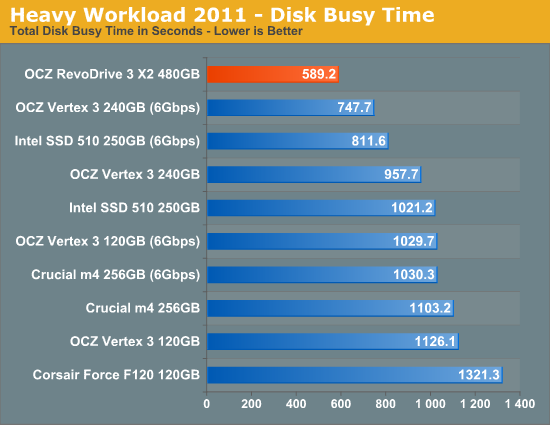
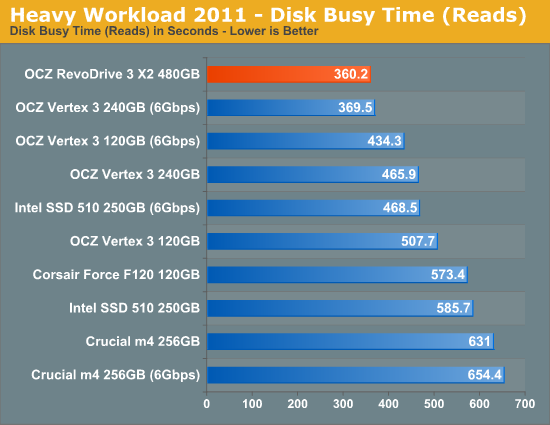
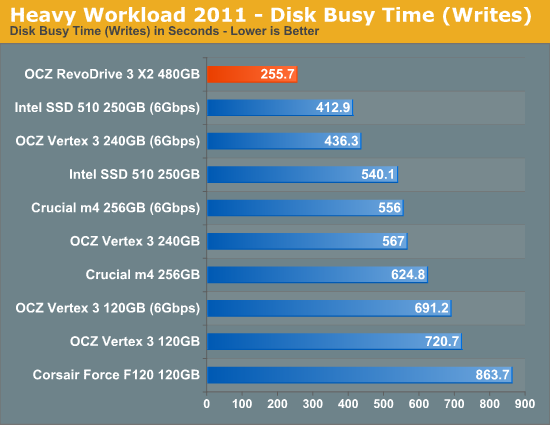










38 Comments
View All Comments
HMTK - Tuesday, June 28, 2011 - link
Would be nice to see one of these against a Fusion IO drive. Those are enterprise PCIe SSD's but I wonder how they'd compare.You should try to get one for Johan and test it under vSphere.
davegraham - Tuesday, June 28, 2011 - link
a more direct comparison would be with the LSI Warpdrive. TBH, OCZ still isn't ready for prime time in the enterprise regardless of who's ASIC they're using. If they want to play with the big boys, they need a solid support staff and design team in place.one quick quirk with this card is the full height, half-depth design + daughterboard. in a card-dense chassis (esp. 1U systems), this won't fly. An LSI WarpDrive, for contrast, is half-height, half-depth @ 300GB.
dave
skrewler2 - Tuesday, June 28, 2011 - link
I don't know why you think enterprise means they need 'solid support'. This may be true for some organizations, but probably does not apply to the companies that would actually be interested in seeing these benchmarks.HMTK - Tuesday, June 28, 2011 - link
I think as in support for (server) OS's other than Windows. These things could be nice for desktop virtualization. There you typically don't need lots of disk space but you need massive IO when people start working and stuff. Bootstorms kill VDI.davegraham - Tuesday, June 28, 2011 - link
This card wouldn't do a bad job at bootstorms for VDI use cases but the WarpDrive's forte is going to show up there pretty strongly. ;)davegraham - Tuesday, June 28, 2011 - link
OCZ is deciding to move upmarket and not just focus on consumers and SMB anymore. when that move occurs, they need to have an ecosystem that will support the inclusion of these devices in systems, not just try to price themselves into systems. OCZ also has a storied history of reliability issues that are going to impact this as well.MrSpadge - Tuesday, June 28, 2011 - link
Storagereview.com has it compared to the LSI Warpdrive.MrS
davegraham - Tuesday, June 28, 2011 - link
interesting review with the knowledge that most of the workloads i've used the warpdrive for are shown to be it's forte...and it's still a generation behind in ASICs (SF-1200 vs SF-2xxx). I know there'll be a refresh of that part. ;)parsec21 - Tuesday, June 28, 2011 - link
Storage Review just did a side by side review of the Revo and Warp cards although they are intended for different markets. For a fraction of the price the OCZ Revo outclassed or matched the LSI Warp in most real world benchmarks. The only areas where the Warp led were due to it having HW RAID with six SF1200 processors tied to SLC memory along with a $8000-$10000 price tag.
The results show that the design team at OCZ utlizing a custom virtual controller and async MLC memory created a product that offers a great deal of performance for a pretty good price.
storagereview.com/ocz_revodrive_3_x2_480gb_review
skrewler2 - Tuesday, June 28, 2011 - link
I was about to include that in my post but saw you beat me to it. Would definitely be interested in that as well.